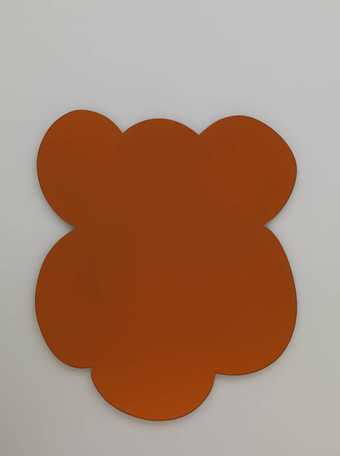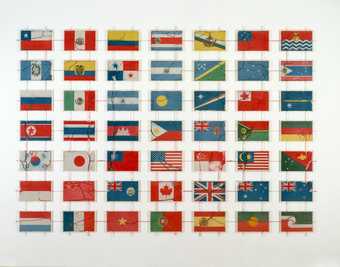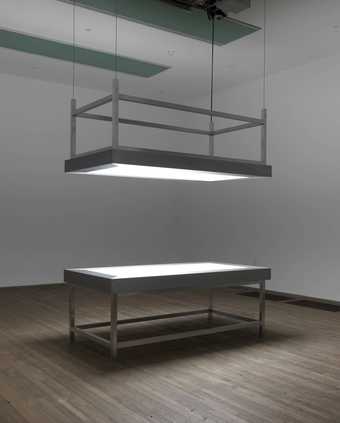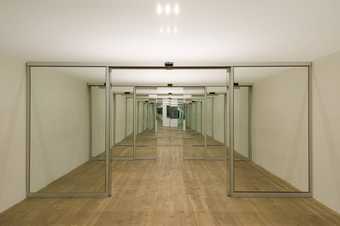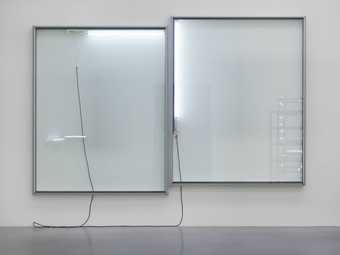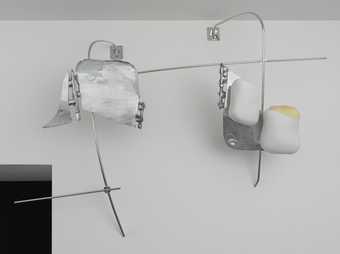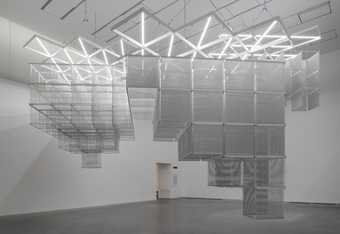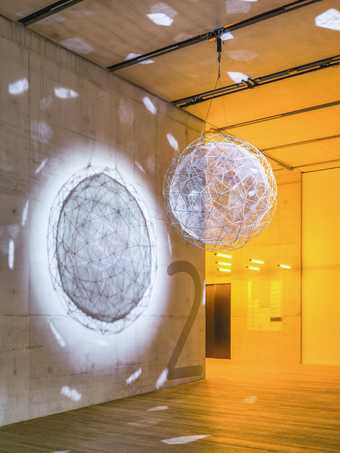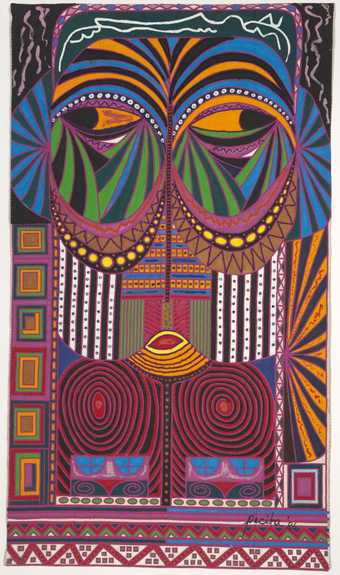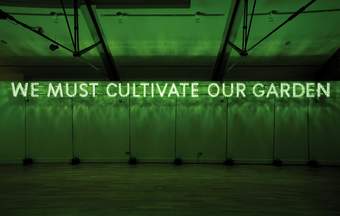
In Tate Modern
- Artist
- Yayoi Kusama born 1929
- Medium
- Chandelier, steel, aluminium, mirrored glass, acrylic, motor, plastic and leds
- Dimensions
- Displayed: 3835 × 5574 × 4828 mm
- Collection
- Tate
- Acquisition
- Presented by a private collector, New York 2019
- Reference
- T15202
Summary
Chandelier of Grief 2016 is first encountered in the gallery setting as a white hexagonal structure, measuring nearly four metres high. The viewer is permitted to enter the room via a sliding door and, once this is closed behind them, enters into a mirrored environment in which a sole light source is a baroque-style chandelier suspended above head-height from the ceiling of the structure. The chandelier is fixed to a rotating mechanism and, combined with its flickering, pulsating lights and the mirrored walls, is intended to create a destabilising yet mesmerising effect.
The elegiac and ambiguous title of the work, though not representing any particular event in Kusama’s personal narrative, is consistent with her interest in representing through her art complex psychological states, such as mourning; in this regard, the work complements the earlier The Passing Winter 2005, also in Tate’s collection (Tate T12821). Physically, it expands upon her methodical use of repetition in her early paintings and is in keeping with the trajectory of Kusama’s pioneering ‘infinity rooms’ – immersive installations which exploit the disorienting properties of mirrors to create the effect of endless replication.
There are approximately twenty distinct mirrored rooms by Kusama, the earliest of which were created when the artist was living and working in New York in the 1960s – Infinity Mirror Room – Phalli’s Field 1965 and Kusama’s Peep Show – Endless Love Show 1966. Since the 2000s the infinity rooms have typically been darkened spaces with many small lights, alluding to a galaxy of stars and enhancing the sensation of being transported to a physical world beyond the earth’s atmosphere. Whilst other examples of these installations focus on Kusama’s long-term preoccupation with dots, kabocha squashes and phallic forms, Chandelier of Grief uniquely raises the focal point from the ground, directing the viewer’s gaze upwards and emphasising the participatory aspect of the installation. Ultimately, Chandelier of Grief is exemplary of Kusama’s practice as a persistent enquiry into the phenomenological potential of art, in which self and environment become indistinguishable and repetition of forms is employed to assert the overwhelming multiplicity of the universe. As such, these works situate Kusama in the legacy of artists throughout history who have attempted to reconcile and subvert the ways in which perspective is perceived in both art and reality.
The notion of self-perception has been a persistent theme throughout Kusama’s practice, exemplified by the work Narcissus Garden 1966, an outdoor presentation of 1,500 silver globes which was first staged on the lawn in front of the Italian Pavilion at the 33rd Venice Biennale in the same year. Despite Kusama’s voluntary confinement to a psychiatric hospital since 1977, her work has remained engaged with new technology, both in the materials she has incorporated into her pieces and in anticipating the ways in which audiences now disseminate images of their encounters with her immersive works on social media platforms, thereby echoing the theme of ceaseless repetition.
Chandelier of Grief exists in an edition of three, of which Tate’s copy is the second; the first in the edition was premiered at the artist’s monographic exhibition at Victoria Miro gallery in Wharf Road, London in 2016.
Further reading
Yayoi Kusama, exhibition catalogue, Victoria Miro, London 2016, illustrated, unpaginated.
Yayoi Kusama: Infinity Mirrors, exhibition catalogue, Hirshhorn Museum and Sculpture Garden, Washington D.C. 2017.
Katy Wan
July 2018
Does this text contain inaccurate information or language that you feel we should improve or change? We would like to hear from you.
Display caption
For Kusama, the experience of art is about more than just looking. It can also be about stepping into the artwork and being immersed in it. From the outside, Chandelier of Grief is a white, hexagonal pod. But inside, the reflected space goes on forever. An ornate chandelier with flickering lights rotates from the ceiling. A never-ending field of lights surrounds you. Our reflections form part of the experience. This means every visit is unique.
Kusama called this work Chandelier of Grief. It suggests that we can experience beauty and sadness at the same time.
Gallery label, April 2021
Does this text contain inaccurate information or language that you feel we should improve or change? We would like to hear from you.
You might like
-
Robert Therrien No Title (Table and Four Chairs)
2003 -
Jeff Koons MONKEY (Red-Orange)
1999 -
Yukinori Yanagi Pacific
1996 -
Alfredo Jaar Lament of the Images
2002 -
Carsten Höller Sliding Doors
2003 -
Yayoi Kusama The Passing Winter
2005 -
Pedro Cabrita Reis Unframed #3
2008 -
Tamás Kaszás Shanty Tower
2014 -
Nairy Baghramian Scruff of the Neck (UL9/10, E)
2016 -
Monir Shahroudy Farmanfarmaian Pentagon
2008 -
Olafur Eliasson Stardust particle
2014 -
Yayoi Kusama Infinity Mirrored Room - Filled with the Brilliance of Life
2011/2017 -
Pacita Abad Bacongo III
1986 -
Nathan Coley We Must Cultivate Our Garden
2006


